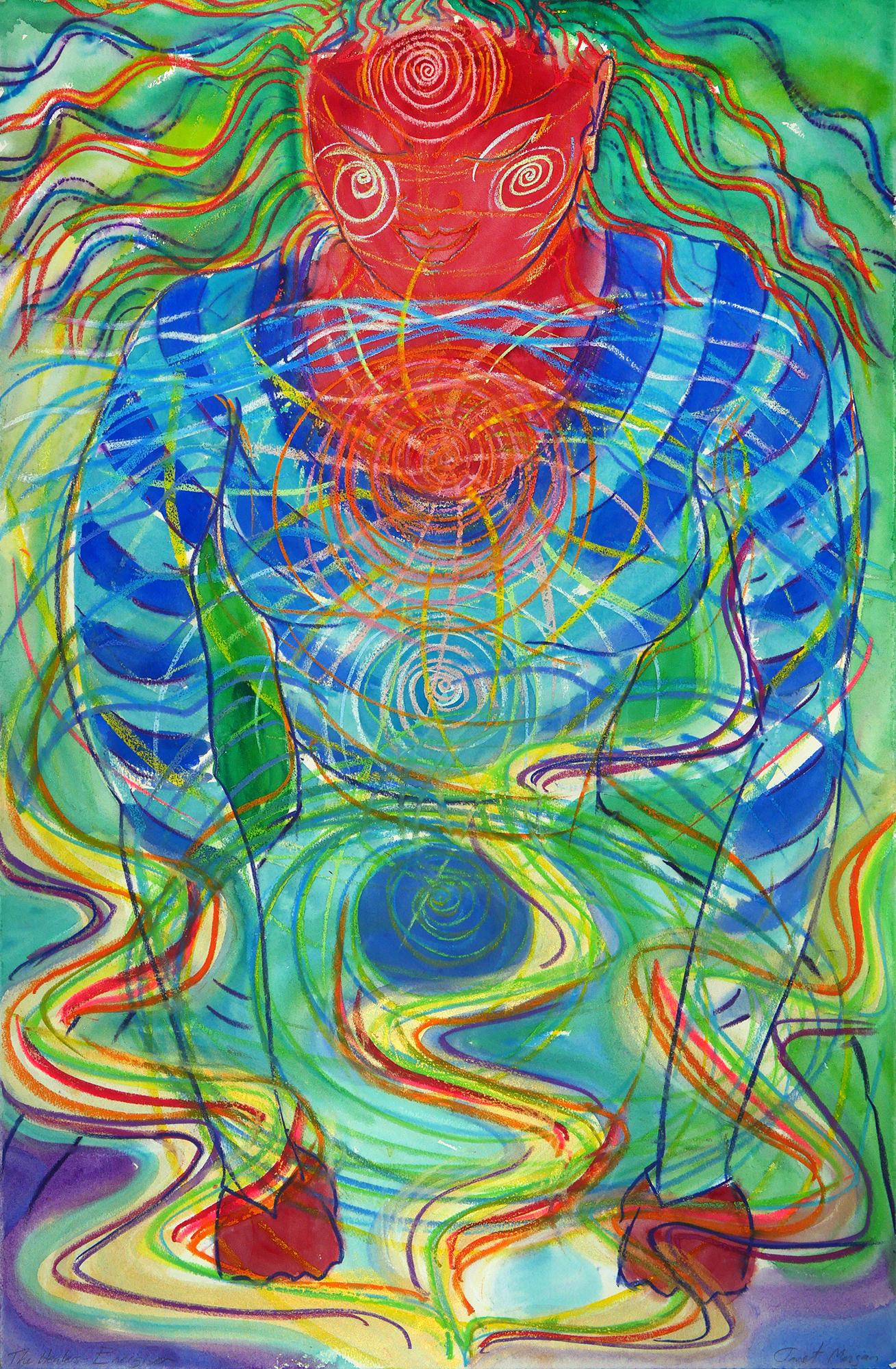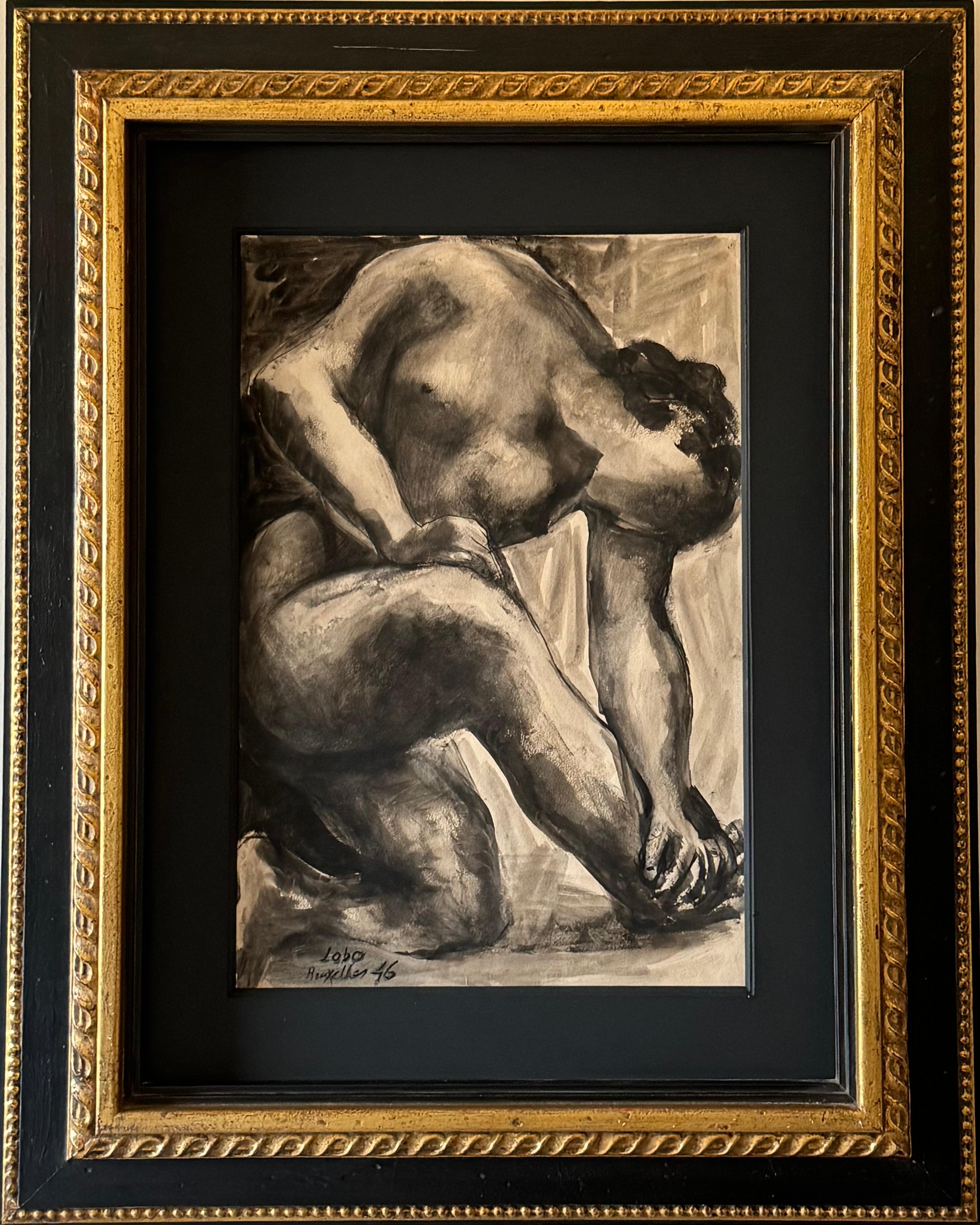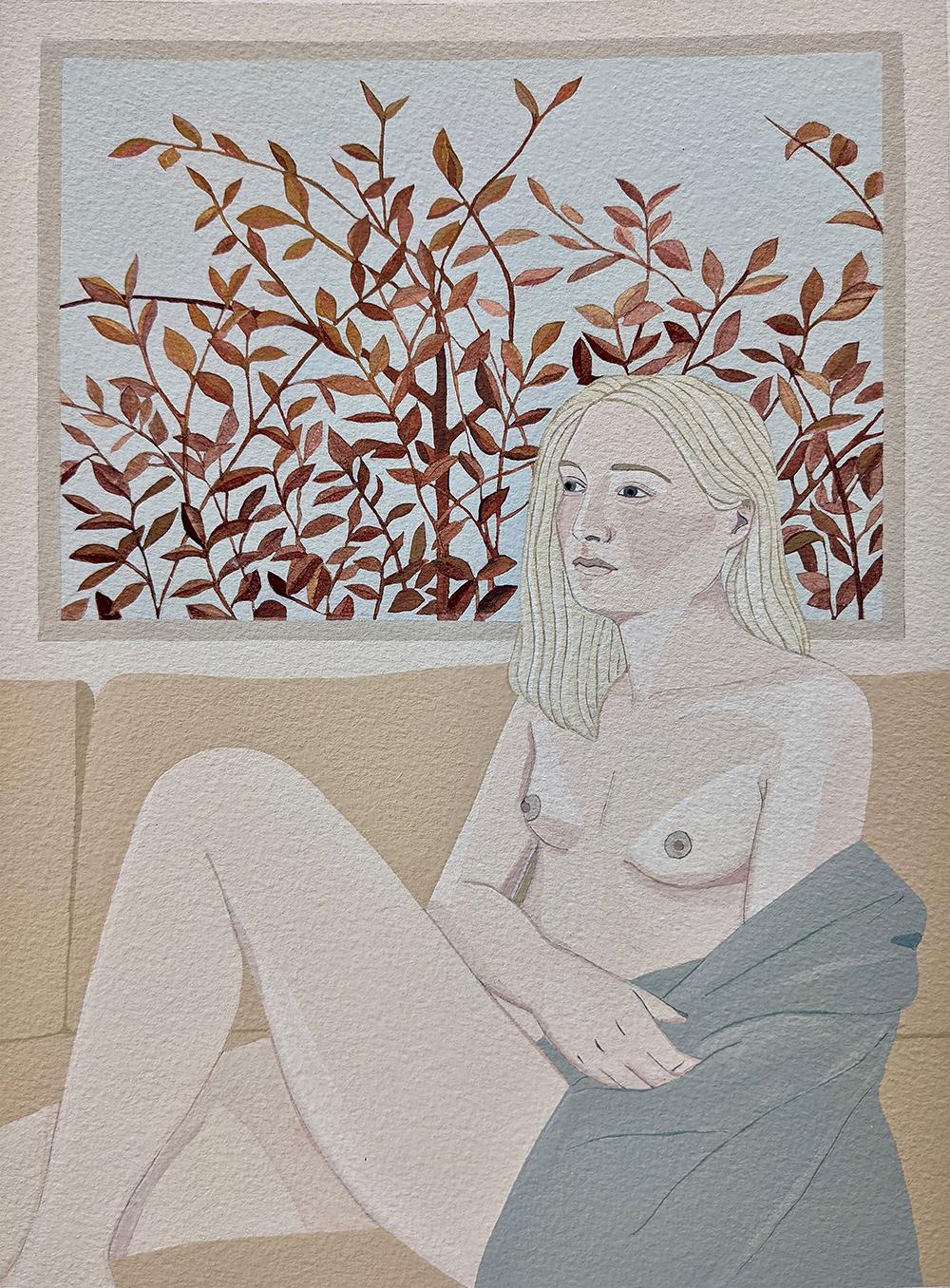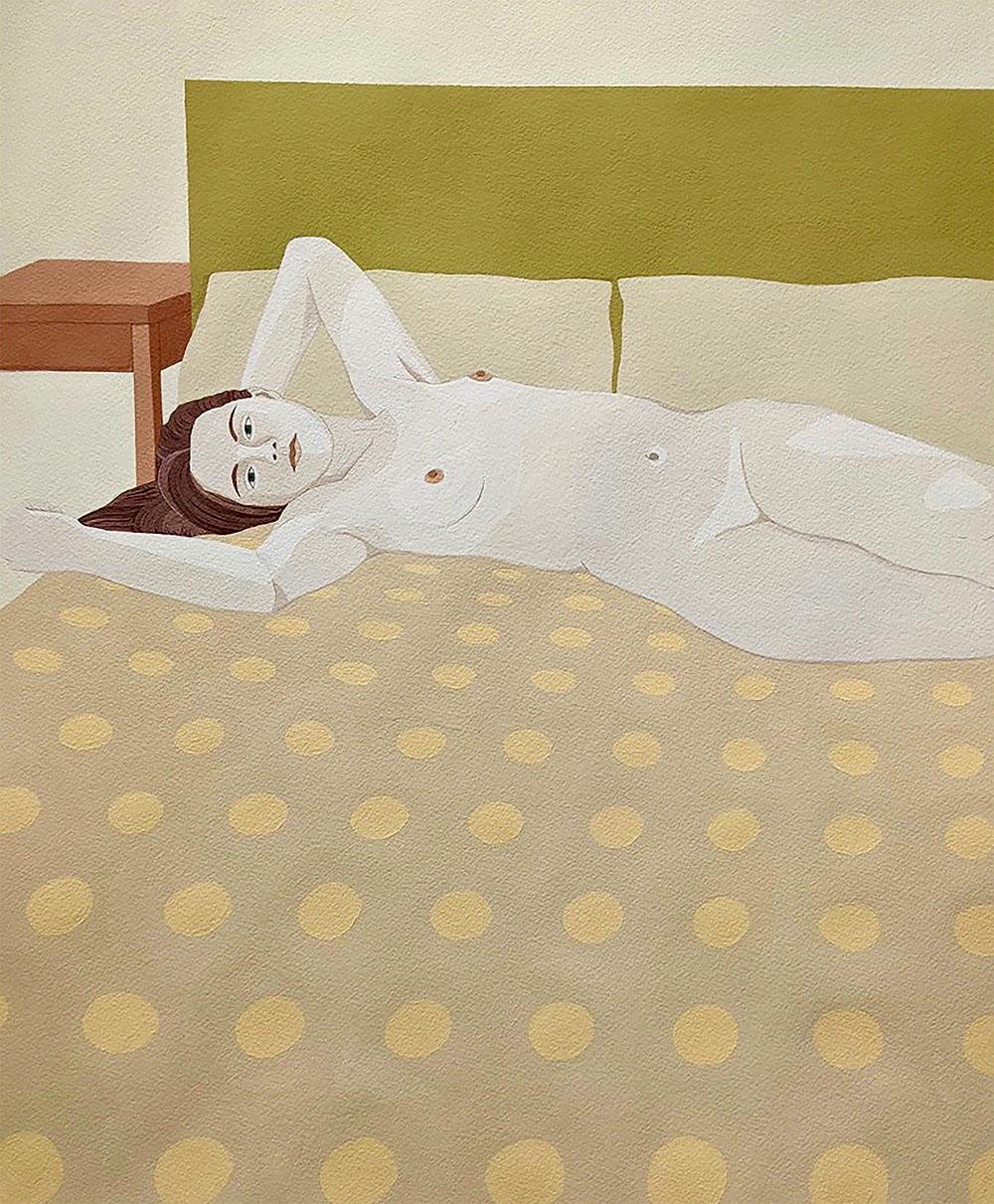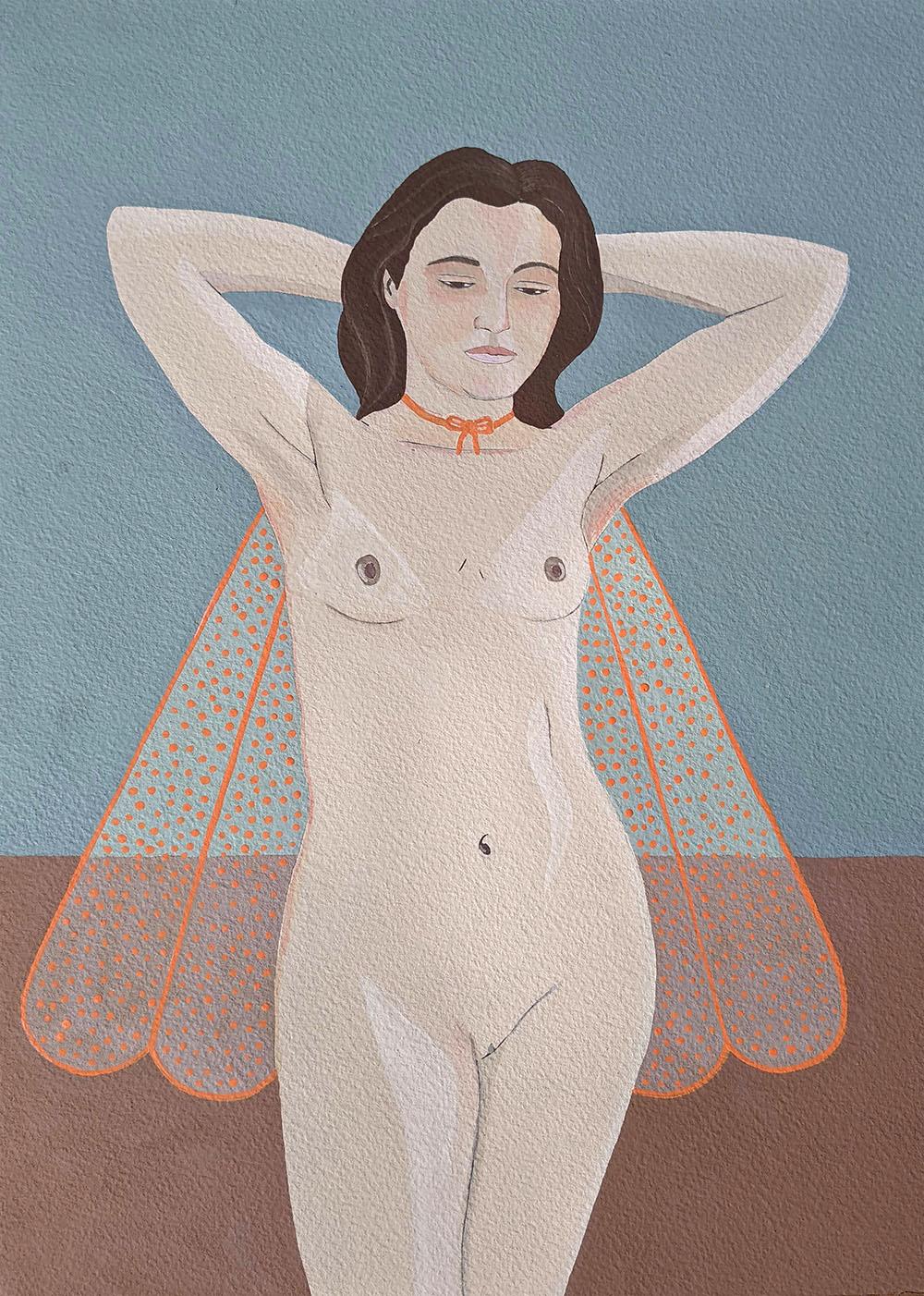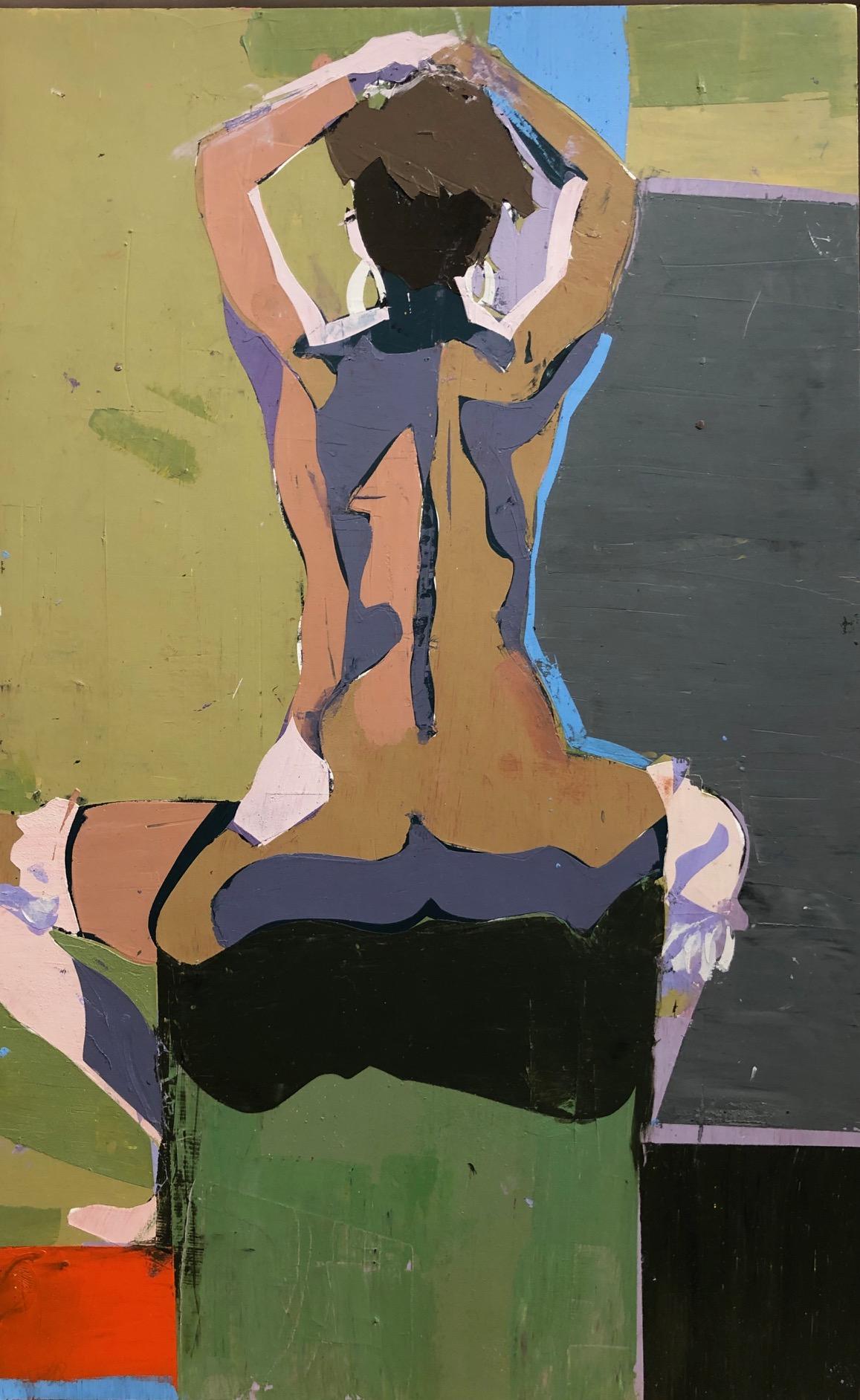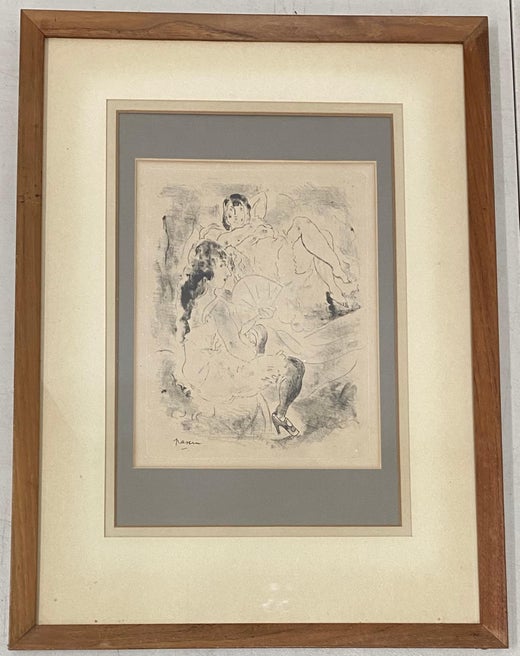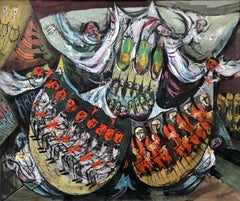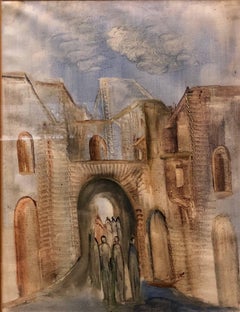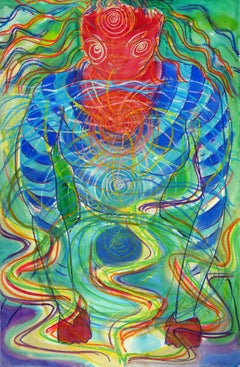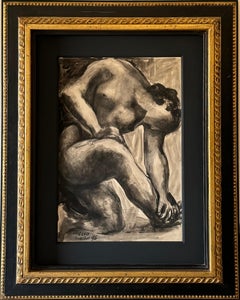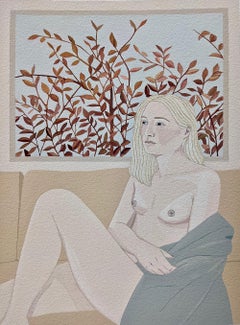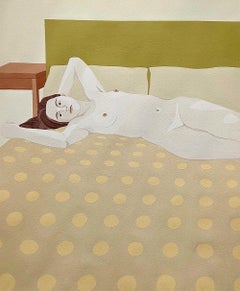Items Similar to Gouache Painting Jules Pascin Hand Signed Woman in Boudoir German Expressionism
Want more images or videos?
Request additional images or videos from the seller
1 of 15
Jules PascinGouache Painting Jules Pascin Hand Signed Woman in Boudoir German Expressionismc.1930's
c.1930's
About the Item
Genre: German Expressionist
Subject: Woman
Medium: gouache paint
Surface: Paper board
This is hand signed lower right.
Framed it measures 17.25 X 15.5, sheet 12 X 10
This came from a Jewish estate. there was no additional paperwork or provenance.
Julius Mordecai Pincas (March 31, 1885 – June 5, 1930), known as Pascin Jules Pascin, or the "Prince of Montparnasse", was a Bulgarian artist known for his paintings and drawings. He later became an American citizen. His most frequent subject was women, depicted in casual poses, usually nude or partly dressed.
Pascin was educated in Vienna and Munich. He traveled for a time in the United States, spending most of his time in the South. He is best known as a Parisian painter, who associated with the artistic circles of Montparnasse, and was one of the emigres of the School of Paris. Having struggled with depression and alcoholism, he committed suicide at the age of 45.
Julius Mordecai Pincas was born in Vidin, Bulgaria, the eighth of eleven children, to the Sephardic Jewish family of a grain merchant named Marcus Pincas. Originally from Ruse, the Pincas family was one of the wealthiest in Vidin; they bought and exported corn, rice, maize and sunflower. His mother, Sofie (Sophie) Pincas, belonged to a Sephardic family, Russo, which had moved from Trieste to Zemun, where she and her husband lived before moving to Vidin and where their older children were born. The family spoke Ladino Judaeo-Spanish at home. In 1892, he moved with his parents to Bucharest, where his father opened a grain company, "Marcus Pincas & Co". Pascin worked briefly for his father’s firm at the age of fifteen, but also frequented a local brothel where he made his earliest drawings. His first artistic training was in Vienna in 1902 at age seventeen. In 1903 he relocated to Munich, where he studied at Moritz Heymann's academy. He studied briefly in Berlin where he befriended the Dada artist George Grosz. In 1905 he began contributing drawings to Simplicissimus, a satirical magazine published in Munich. Some portraits recall Otto Dix and Balthus. Because his father objected to the family name being associated with these drawings, the 20-year-old artist adopted the pseudonym Pascin (an anagram of Pincas). He continued to contribute drawings to a Munich daily until 1929.
In December 1905, Pascin moved to Paris becoming part of the great migration of Jewish and Eastern European artists to that city (Marc Chagall. Chaim Soutine and Amedeo Modigliani amongst others) at the start of the 20th century. In 1907 he met Hermine Lionette Cartan David, also a painter, and they became lovers. In that same year he had his first solo exhibition at Paul Cassirer Gallery in Berlin. Despite his social life, Pascin created thousands of watercolors and sketches, plus drawings and caricatures that he sold to various newspapers and magazines. He exhibited his works in commercial galleries and in the Salon d’Automne, the Salon des Indépendants, and the exhibitions of the Berlin Secession and at the Sonderbund-Ausstellung in Cologne. Between 1905 and 1914 he exhibited drawings, watercolors, and prints, but rarely paintings. It was not until about 1907–1909 that he produced his first paintings, which were portraits and nudes in a style influenced by Fauvism and Cézanne. He wanted to become a serious painter, but in time he became deeply depressed over his inability to achieve critical success with his efforts. Dissatisfied with his slow progress in the new medium, he studied the art of drawing at the Académie Colarossi, and painted copies after the masters in the Louvre. He exhibited in the United States for the first time in 1913, when twelve of his works were shown at the Armory Show in New York.
Pascin relocated to London at the outbreak of World War I to avoid service in the Bulgarian army and left for the United States on October 3, 1914. A few weeks later on October 31, Hermine David sailed for the United States to join him.
Pascin and David lived in the United States from 1914 to 1920, sitting out World War I. They visited New York City, where David had an exhibit. Pascin frequented nightclubs, and met artists such as Yasuo Kuniyoshi and Guy Pene du Bois, but most of his time in America was spent traveling throughout the South. He also visited Cuba. He made many drawings of street life in Charleston, New Orleans, and other places he visited. Some of his works of 1915 and 1916 are in a Cubist style, which he soon abandoned.
In 1918 Pascin married Hermine David at City Hall in New York City. Their witnesses were Max Weber and Maurice Sterne, friends and painters who both lived in New York. In September 1920, Pascin became a naturalized United States citizen, with support from Alfred Stieglitz and Maurice Sterne, but returned to Paris soon afterward. There he began a relationship with Lucy Vidil Krohg, who had been his lover ten years earlier but had married the Norwegian painter Per Krohg during Pascin's years in America.
Especially after he returned to France, he became the symbol of the Montparnasse artistic community and is more associated with France than the United States. Always in his bowler hat, he was a witty presence, along with his good friend Constant Detré, at Le Dôme Café, Jockey-Club de Paris, and the other haunts of the area’s bohemian society. Pascin visited Bulgaria in 1923 and 1924 and at an uncertain later date.
Like Henri de Toulouse-Lautrec, Pascin drew upon his surroundings and his friends, both male and female, as subjects. During the 1920s, Pascin mostly painted fragile petites filles, prostitutes waiting for clients, or models waiting for the sitting to end. His fleetingly rendered paintings sold readily, but the money he made was quickly spent. Famous as the host of numerous large parties in his flat, whenever he was invited elsewhere for dinner, he arrived with as many bottles of wine as he could carry. He frequently led a large group of friends on summer picnics beside the River Marne, where their excursions lasted all afternoon.
According to his biographer, Georges Charensol:
Scarcely had he chosen his table at the Dôme or the Sélect than he would be surrounded by five or six friends; at nine o'clock, when we got up to dinner, we would be 20 in all, and later in the evening, when we decided to go up to Montmartre to Charlotte Gardelle's or the Princess Marfa's—where Pascin loved to take the place of the drummer in the jazz band—he had to provide for
Among Pascin's circle of Parisian friends was Ernest Hemingway, whose memoir A Moveable Feast includes a chapter titled "With Pascin At the Dôme", which recounts a night in 1923 when he met Pascin and two of his young models for drinks at the café.
Exhibitions:
Galerie Berthe Weill, Paris
Berlin Secession
Sounder bund-Ausstellung, Cologne
Armory Show New York
Salon d’Automne, Paris
Salon des Indépendants, Paris
Paul Cassirer
Berlin Photographic Company New York
Joseph Brummer Gallery
Galerie Pierre, Paris
Alfred Flechtheim Gallery, Dusseldorf
Knoedler Gallery, NY
Galerie Lucy Krohg, Paris
Bezalel National Art Museum, Jerusalem, Israel
University Art Museum at UC Berkeley
UCLA
Whitney Museum of American Ar
Galerie des Beaux-arts, Bordeaux
Haus der Kunst, Munich
Musée d’Art Histoire, Geneva
Palais de la Méditerranée in Nice
National Museum, Belgrade
Galeries Nationales du Grand-Palais, Paris
Hotel de Ville, Paris
Musée-Galerie de la Seita, Paris.
- Creator:Jules Pascin (1885-1930, Bulgarian, French)
- Creation Year:c.1930's
- Dimensions:Height: 17.25 in (43.82 cm)Width: 15.5 in (39.37 cm)
- Medium:
- Movement & Style:
- Period:
- Condition:good. please see photos. paper is in age appropriate condition. needs new backing. toning to paper. light chips at corners under the mat. needs new filet liner. frame is in good condition.
- Gallery Location:Surfside, FL
- Reference Number:1stDibs: LU38210170922
Jules Pascin
Jules Pascin was born Julius Mordecai Pincas, in Widdin, Bulgaria to a Spanish-Sephardic Jewish father and a Serbian-Italian mother. His early artistic training was in Vienna and Munich. In 1905, at the age of 20, he adopted the pseudonym Pascin (an anagram of Pincas). About the same time, he began contributing drawings to Simplicissimus, a satirical magazine published in Munich. In December 1905, Pascin moved to Paris, becoming part of the great migration of artists to that city at the start of the 20th century. In 1907, Pascin met Hermine Lionette Cartan David, also a painter, and they became lovers. They lived together until Pascin left for America on October 3, 1914. A few weeks later on October 31, Hermine David sailed for the United States to join Pascin. Pascin lived in the United States from 1914 to 1920, sitting out World War I. He taught at the Telfair Academy in Savannah, Georgia, associated with the Telfair Art Museum. He and Hermine painted in New York City as well as in Miami, New Orleans, and Cuba. Despite his social life, Pascin created thousands of watercolors and sketches, plus drawings and caricatures, which he sold to various newspapers and magazines. He studied the art of drawing at the Académie Colarossi and, like Henri de Toulouse-Lautrec, he drew upon his surroundings and his friends, both male and female, as subjects. He wanted to become a serious painter, but in time, he became deeply depressed over his inability to achieve critical success with his efforts. During the 1920s, Pascin mostly painted fragile petites filles, prostitutes waiting for clients, or models waiting for the sitting to end. His fleetingly rendered paintings sold readily, but the money he made was quickly spent. Famous as the host of numerous large parties in his flat, whenever he was invited elsewhere for dinner, he arrived with as many bottles of wine as he could carry. He frequently led a large group of friends on summer picnics beside the River Marne, where their excursions lasted all afternoon. Ernest Hemingway's chapter titled "With Pascin At the Dôme," in A Moveable Feast, recounted a night in 1923 when he had stopped off at Le Dôme and met Pascin escorted by two models. Hemingway's portrayal of the evening is considered one of the defining images of Montparnasse at the time. Pascin struggled with depression and alcoholism. "[D]riven to the wall by his own legend," according to art critic Gaston Diehl, he committed suicide at the age of 45 on the eve of a prestigious solo show. He slit his wrists and hung himself in his studio in Montmartre. On the wall he left a message written in blood, to a former lover, Cecile (Lucy) Vidil Krohg In his last will and testament, Pascin left his estate equally to his wife, Hermine David, and his mistress Lucy Krohg.
About the Seller
4.9
Platinum Seller
Premium sellers with a 4.7+ rating and 24-hour response times
Established in 1995
1stDibs seller since 2014
1,760 sales on 1stDibs
Typical response time: 1 hour
- ShippingRetrieving quote...Shipping from: Surfside, FL
- Return Policy
Authenticity Guarantee
In the unlikely event there’s an issue with an item’s authenticity, contact us within 1 year for a full refund. DetailsMoney-Back Guarantee
If your item is not as described, is damaged in transit, or does not arrive, contact us within 7 days for a full refund. Details24-Hour Cancellation
You have a 24-hour grace period in which to reconsider your purchase, with no questions asked.Vetted Professional Sellers
Our world-class sellers must adhere to strict standards for service and quality, maintaining the integrity of our listings.Price-Match Guarantee
If you find that a seller listed the same item for a lower price elsewhere, we’ll match it.Trusted Global Delivery
Our best-in-class carrier network provides specialized shipping options worldwide, including custom delivery.More From This Seller
View AllEtching with Hand Watercolor Painting Jules Pascin Pencil Signed
By Jules Pascin
Located in Surfside, FL
Genre: German Expressionist
Subject: Figures
Medium: etching, watercolor paint
Surface: Paper
This is hand signed lower right.. there does not seem to be an edition size although th...
Category
Early 20th Century Expressionist Figurative Drawings and Watercolors
Materials
Paper, Watercolor, Etching
German Expressionist Drawing, Watercolor Painting Jules Pascin Cuba Scene 1910
By Jules Pascin
Located in Surfside, FL
Genre: German Expressionist
Subject: Woman, Cuban Scene
Medium: watercolor paint, ink or pencil
Surface: Paper
This is hand signed lower right.
There is an inscription at bottom e...
Category
1910s Expressionist Figurative Drawings and Watercolors
Materials
Paper, Ink, Watercolor
Modernist Orchestra Musical Gouache Painting Boston Expressionist
By David Aronson
Located in Surfside, FL
Very vibrant, dynamic orchestra scene reminiscent of the work of Mopp (Max Oppenheim)
David Aronson, (1923-2015) son of a rabbi, was born in Lithuania in 1923 and immigrated to America at the age of five. He settled in Boston, Massachusetts where he studied at the school of the Museum of Fine Arts under Karl Zerbe, a German painter well known in the early 1900s. Aronson later taught at the school of the Museum of Fine Arts for fourteen years and founded the School of Fine Art at Boston University where he is today a professor emeritus. An internationally renowned sculptor & painter, Aronson has won acclaim for his interpretation of themes from the Hebrew Talmud and Kabala. His best known works include bronze castings, encaustic paintings, and pastels. His work is included in many important public and private collections, and has been shown in several museum retrospectives around the country. He is considered to be one of the most important 20th century American artists.
At twenty-two David Aronson had his first one-man show at New York's Niveau Gallery. The next year, six of his Christological paintings were included in the Fourteen Americans exhibition at Manhattan's Museum of Modern Art where Aronson’s work was included alongside abstract expressionists Arshile Gorky, Robert Motherwell and Isamu Noguchi. In the 1950s, Aronson turned more toward his Jewish heritage for the inspiration for his art. Folklore as well as Kabalistic and other transcendental writings influenced his work greatly. The Golem (a legendary figure, brought to life by the Maharal of Prague out of clay to protect the Jewish community during times of persecution) and the Dybbuk (an evil spirit that lodges itself in the soul of a living person until exorcised) frequently appear in his work.
In the sixties, Aronson turned to sculpture. His work during this period is best exemplified by a magnificent 8’ x 4’ bronze door which now stands at the entrance to Frank Lloyd Wright's Johnson Foundation Conference Center for the Arts in Racine, Wisconsin. In the seventies and eighties, Aronson continued his work in pastel drawings, paintings, and sculptures, often exploring religion and the frailties of man's nature. During this time, in addition to a traveling retrospective exhibition and many one-man shows in New York, Los Angeles, Chicago, and Boston at the Pucker-Safrai Gallery on Newbury Street, Aronson won many awards and became a member of the National Academy of Design in New York. Two years ago he retired from teaching to work full-time in his studio in Sudbury, Massachusetts.
included in the catalog
Contemporary Religious Imagery in American Art
Catalog for an exhibition held at the Ringling Museum of Art, March 1-31, 1974.
Artists represented: David Aronson, Leonard Baskin, Max Beckmann, Hyman Bloom, Fernando Botero, Paul Cadmus, Marvin Cherney, Arthur G. Dove, Philip Evergood, Adolph Gottlieb, Jonah Kinigstein, Rico Lebrun, Jack Levine, Louise Nevelson, Barnett Newman, Abraham Rattner, Ben Shahn, Mark Tobey, Max Weber, William Zorach and others.
Selected Awards
1990, Certificate of Merit, National Academy of Design
1976, Purchase Prize, National Academy of Design
1976, Joseph Isidore Gold Medal, National Academy of Design
1976, Purchase Prize in Drawing, Albrecht Art Museum
1975, Isaac N. Maynard Prize for Painting, National Academy of Design
1973, Samuel F. B. Morse Gold Medal, National Academy of Design
1967, Purchase Prize, National Academy of Fine Arts
1967, Adolph and Clara Obrig Prize, National Academy of Design
1963, Gold Medal, Art Directors Club of Philadelphia
1961, 62, 63, Purchase Prize, National Institute of Arts and Letters
1960, John Siimon Guggenheim Fellowship
1958, Grant in Art, National Institute of Arts and Letters
1954, First Prize, Tupperware Annual Art Fund Award
1954, Grand Prize, Third Annual Boston Arts Festival
1953, Second Prize, Second Annual Boston Arts Festival
1952, Grand Prize, First Annual Boston Arts Festival
1946, Traveling Fellowship, School of the Museum of Fine Arts
1946, Purchase Prize, Virginia Museum of Fine Arts
1944, First Popular Prize, Institute of Contemporary Art
1944, First Judge's Prize, Institute of Contemporary Art
Selected Public Collections
Art Institute of Chicago
Virginia Museum of Fine Arts
Bryn Mawr College
Brandeis University
Tupperware Museum, Orlando, Florida
DeCordova Museum
Museum of Modern Art Print Collection, New York
Atlanta University
Atlanta Art...
Category
20th Century Expressionist Figurative Paintings
Materials
Gouache, Board
Jerusalem Old City Landscape, Expressionist Judaica Israeli Painting II
By Andre Elbaz
Located in Surfside, FL
In this painting the artist uses gestural brushstrokes, which causes distortion and exaggeration for emotional effect. Andre Elbaz uses as his subject figures walking in old city Jerusalem.
André Elbaz (born April 26, 1934, El Jadida, Morocco) is a famous Moroccan painter and filmmaker.
Elbaz studied art and theatre in Rabat and Paris from 1950 to 1961. He started painting only at the age of 21, until which age he had been interested mainly in theatre. A few years later, he managed to combine his two passions into a new approach in art-therapy, inventing together with his wife, a psychiatrist, the Pictodrame, which brought him world recognition.
His first exhibition, which was very successful, took place in Casablanca in 1961 and earned him an appointment as Professor at the Beaux-Arts school in Casablanca. Years later, in 1976, he exhibited his paintings at the Tel-Aviv Museum.
In parallel to his career as a painter, Elbaz is also known as a filmmaker. He produced several short films in France, Canada and the United States. One of them, La nuit n'est jamais complète (The night is never complete), won a prize at the "5th Biennale de Paris in 1967". Among the themes chosen for the many films he produced, there was a short one about the Warsaw Ghetto uprising, as well as a series of drawings entitled Seuls (Alone), with texts written by both Elie Wiesel...
Category
20th Century Expressionist Figurative Paintings
Materials
Paper, Gouache
Jerusalem Old City Landscape, Expressionist Judaica Israeli Painting
By Andre Elbaz
Located in Surfside, FL
In this painting the artist uses gestural brushstrokes, which causes distortion and exaggeration for emotional effect. Andre Elbaz uses as his subject figures walking in old city Jerusalem.
André Elbaz (born April 26, 1934, El Jadida, Morocco) is a famous Moroccan painter and filmmaker.
Elbaz studied art and theatre in Rabat and Paris from 1950 to 1961. He started painting only at the age of 21, until which age he had been interested mainly in theatre. A few years later, he managed to combine his two passions into a new approach in art-therapy, inventing together with his wife, a psychiatrist, the Pictodrame, which brought him world recognition.
His first exhibition, which was very successful, took place in Casablanca in 1961 and earned him an appointment as Professor at the Beaux-Arts school in Casablanca. Years later, in 1976, he exhibited his paintings at the Tel-Aviv Museum.
In parallel to his career as a painter, Elbaz is also known as a filmmaker. He produced several short films in France, Canada and the United States. One of them, La nuit n'est jamais complète (The night is never complete), won a prize at the "5th Biennale de Paris in 1967". Among the themes chosen for the many films he produced, there was a short one about the Warsaw Ghetto uprising, as well as a series of drawings entitled Seuls (Alone), with texts written by both Elie Wiesel...
Category
20th Century Expressionist Figurative Paintings
Materials
Paper, Gouache
Three Rabbis at The Torah, Expressionist Judaica Painting
By Andre Elbaz
Located in Surfside, FL
In this painting the artist uses gestural brushstrokes, which causes distortion and exaggeration for emotional effect. Andre Elbaz uses as his subject three male figures with tefilin are depicted during prayer.
André Elbaz (born April 26, 1934, El Jadida, Morocco) is a famous Moroccan painter and filmmaker.
Elbaz studied art and theatre in Rabat and Paris from 1950 to 1961. He started painting only at the age of 21, until which age he had been interested mainly in theatre. A few years later, he managed to combine his two passions into a new approach in art-therapy, inventing together with his wife, a psychiatrist, the Pictodrame, which brought him world recognition.
His first exhibition, which was very successful, took place in Casablanca in 1961 and earned him an appointment as Professor at the Beaux-Arts school in Casablanca. Years later, in 1976, he exhibited his paintings at the Tel-Aviv Museum.
In parallel to his career as a painter, Elbaz is also known as a filmmaker. He produced several short films in France, Canada and the United States. One of them, La nuit n'est jamais complète (The night is never complete), won a prize at the "5th Biennale de Paris in 1967". Among the themes chosen for the many films he produced, there was a short one about the Warsaw Ghetto uprising, as well as a series of drawings entitled Seuls (Alone), with texts written by both Elie Wiesel...
Category
20th Century Expressionist Figurative Paintings
Materials
Paper, Gouache
You May Also Like
Energy Worker, bright colorful swirling patterns mystical yoga Wild Woman
By Janet Morgan
Located in Brooklyn, NY
This painting is in a series called the Wild Woman which is also printed in a pocket sized book.
Watercolor, mixed media, using resists.
Janet Morgan’s...
Category
2010s Expressionist Nude Drawings and Watercolors
Materials
Mixed Media, Watercolor, Archival Paper
BALTASAR LOBO 1946 Seated Female Nude Abstract Figure Gouache & Ink on Paper
By Baltasar Lobo
Located in Rancho Santa Fe, CA
BALTASAR LOBO
Abstract Seated Nude Female Figure
1946
Gouache & Ink on Paper
Provenance: Ivan Boesky Collection, La Jolla, California
Signed & Dated "Lobo '46 Bruxelles"
Baltasar...
Category
1940s Abstract Figurative Paintings
Materials
Paper, Ink, Watercolor, Gouache
Under the Red Leaves gouache painting of female nude, pastel colors, white frame
By Ellen Von Wiegand
Located in Dallas, TX
Beautiful original gouache paintings on Arches watercolour paper by Ellen Von Wiegand are framed in white, all archival materials, and ready to hang. "Under the Red Leaves" is a gorg...
Category
2010s Contemporary Figurative Paintings
Materials
Gouache, Archival Paper
The Sun Dazzled the House with Light, gouache painting of female nude on yellow
By Ellen Von Wiegand
Located in Dallas, TX
Beautiful original gouache paintings on Arches watercolour paper by Ellen Von Wiegand are float mounted and framed in white, all archival materials, and ready to hang. "The Sun Dazzl...
Category
2010s Contemporary Figurative Paintings
Materials
Gouache, Archival Paper
Fitted Wings, gouache painting of female nude with wings, blue background, frame
By Ellen Von Wiegand
Located in Dallas, TX
Beautiful original gouache paintings on Arches watercolour paper by Ellen Von Wiegand are float mounted and framed in white, all archival materials, and ready to hang. "Fitted Wings"...
Category
2010s Contemporary Figurative Paintings
Materials
Gouache, Archival Paper
Carnival Suburbian / 2008 framed figurative painting
By Kim Frohsin
Located in Burlingame, CA
Blue and grey with peach abstracted figurative painting in neutral cool colors from Kim Frohsin's "Figures WIth Edges" series. Frohsin, third generation Bay Area Figurative artist—fr...
Category
21st Century and Contemporary Contemporary Figurative Paintings
Materials
Mixed Media, Acrylic, Gouache
Recently Viewed
View AllMore Ways To Browse
South Street Antiques
German Painting 1920s
German Paintings 1930s
Large Painting Party
Bordeaux Painting
Painting Woman Sitting
1930s Sketch
Wanted Antique Paintings
Merchant Signs
1930s Cubist Painting
Painting Woman 1920s
Painting Of Woman In Hat
Norwegian Painters
Soutine Paintings
Boudoir Art
Petite Paintings
Germany Painting 1905
Corn Sign
